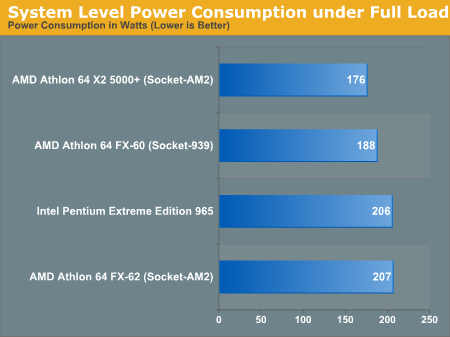AMD Socket-AM2: Same Performance, Faster Memory, Lower Power
by Anand Lal Shimpi on May 23, 2006 12:14 PM EST- Posted in
- CPUs
Power Consumption
Given that AMD reduced power consumption a bit alongside the move to Socket-AM2, we wanted to see how the new chips compared to the latest CPUs AMD had sent us prior to the launch. So we pitted our last Socket-939 sample, the Athlon 64 FX-60, against the two new Socket-AM2 samples we just received: the Athlon 64 FX-62 and the X2 5000+. Remember that the FX-62 actually carries a 125W TDP rating, so it shouldn't be any cooler than previous CPUs, but the X2 5000+ is a new 89W part.
There are inevitably going to be power differences between the Socket-AM2 and Socket-939 motherboards we used, but unfortunately there was no way to isolate them from the comparison as we are measuring total system power consumption.


Under full load, the X2 5000+ does appear to be a bit cooler than the Socket-939 FX-60. We've seen in the past that the 1MB vs. 512KB of cache doesn't really result in any significant difference in power consumption, so it looks like the overall decrease in power consumption is because of the improvements in production AMD has implemented at Fab 30. It is worth noting that the Pentium Extreme Edition 965 consumes just as much power as the FX-62, thanks to its 65nm manufacturing process. Even so, we still can't wait for Intel to drive its power consumption levels even lower later this year.










83 Comments
View All Comments
mlittl3 - Tuesday, May 23, 2006 - link
Until K8L (which will have microarchitectural improvements), there are a few things that could allow AMD to look good against Core 2.1) Price drops so that comparable K8 and Core 2 processors are the same price giving the same performance/$ ratio (this metric is important for the budget constrained)
2) Nov. '06 release of 65 nm AM2 processors so that K8 and Core 2 processors will have the same performance/watt ratio (65 nm could give K8 a 20% drop in power and with Core 2 being 20% faster, they will have the same performance/watt ratio which is popular now). Also, everytime AMD transitions to a new die process they add some minor bug fixes and minor memory/microarchitectural enhancements which could also boost performance by a few percent.
3) Continual improvements to DDR2 latency might yield a 2-2-2 DDR2 800 memory module which will probably benefit K8 more (maybe ~5% improvement) than Core 2 but this is a wild guess here and I don't know if it is even possible. However, DDR400 latency started around 4-4-4 and dropped to 2-2-2 so it could happen.
With the same performance/price and performance/watt as Core 2, K8 could stay competitive and OEMS and users decide on which company (if not both) they would like to do business with. This is all speculation and of course everyone is more than welcome to rip my reasoning to death.
JarredWalton - Tuesday, May 23, 2006 - link
I seriously doubt we will ever see DDR2-800 running at 2-2-2 timings. (Feel free to quote me on this in the future and make fun of me if I'm proven wrong. :-)) Just think how long we had DDR memory around, and no one ever managed to create 1-1-1 DDR-400 memory. I do think we will see 3-3-3 DDR2-800, and possibly even higher bandwidth with those timings. In fact, we almost have that already judging from my experiences so far with socket AM2. (I can post and run benchmarks, but I wouldn't call the system 100% stable.)mlittl3 - Tuesday, May 23, 2006 - link
LOL! I will!MacGuffin - Tuesday, May 23, 2006 - link
From Patriot's PDC22G8000+XBLK Rev. 2 review on PCSTATS.Rated for DDR2-667 @ 3-3-3-9 (Maintains those timings through DDR2-940!)
Rated for DDR2-1000 @ 4-4-4-12 (Goes Up to DDR2-1020!)
Completely stable on the Intel platform they used. It's extremely expensive (saw it for $400+ at NewEgg). But yes, it is possible to run 2GB at these timings already. Its just extremely expensive.
EdisonStarfire - Tuesday, May 23, 2006 - link
any opinions on AMD offering a Clearspeed solution as stop-gap in the high end desktop arena ?Griswold - Tuesday, May 23, 2006 - link
The bottom line is, we now know what we knew last fall, or rather (rightfully) assumed.Now you made me curious. Could that be the "noise in june" which Henri Richards mentioned in a Register interview earlier this month?
smn198 - Wednesday, May 24, 2006 - link
It is called quad-core.temp2 - Tuesday, May 23, 2006 - link
The extremetech.com article has a similar teaser at the end, but it is slightly more specific:
"And given recent discussions with AMD, we can safely say that the company hasn't launched its last FX series CPU for the year quite yet."
mino - Wednesday, May 24, 2006 - link
This provided, 3.2 or even 3.4 FX's on 65nm are on the way...Scrogneugneu - Tuesday, May 23, 2006 - link
Beware the mighty Sempron FX 32 !